To set organisational boundaries for consolidated GHG emissions, ITC has utilised the operational control approach for the various entities covered under the Report. ITC's accounting of Scope 1, 2 & 3 GHG emissions is based on the 'GHG Protocol Corporate Accounting and Reporting Standard' and the 'GHG Protocol Corporate Value Chain (Scope 3) Accounting and Reporting Standard' issued by the World Resources Institute (WRI) and the World Business Council for Sustainable Development (WBCSD).
-
1. Stationary Combustion
Emission factors provided in the IPCC Guideline for National Greenhouse Gas Inventories of 2006 were used to calculate GHG emissions from stationary combustion sources.
Activity data (quantity of fuel consumed) is multiplied with the respective default energy factor or actual measured Net Calorific Value (NCVs) to arrive at the energy consumption values, which is multiplied by the emission factor to quantify the direct emission from stationary combustion sources.
-
2. Purchased Energy
The quantification of indirect GHG emission due to purchased electricity is based on activity data (Electricity consumption in kWh) multiplied by emission factors specified in the 'CO2 Baseline Database for the Indian Power Sector User Guide', (version 10.0, December 2014) issued by Central Electricity Authority, Government of India.
The quantification of indirect GHG emissions for purchased steam is based on activity data (energy consumption in GJ) multiplied by the applicable emission factors provided in the IPCC Guideline for National Greenhouse Gas Inventories of 2006.
-
3. Transportation
The energy consumption outside of the organisation due to road transportation is quantified by using energy conversion factors based on the Report by World Bank on Road Transport Service Efficiency Study (India)-2005.
The modes of transportation used in ITC, for raw materials, finished goods & wastes, employee commuting by means of company owned/hired vehicles, transportation due to guest pick-up in ITC Hotels and sources for calculation of emission factors are as follows:
Road - Emission factors for trucks are calculated based on the Report by World Bank on Road Transport Service Efficiency Study (India)-2005. Emission factors for employee commuting by means of company owned/hired vehicles and transportation due to guest pick-up in ITC Hotels are based on a report by Automotive Research Association of India.
Rail - Emission factors are calculated based on the information available from the Indian Railways Annual report 2013-14, Indian Railways Statistics 2013-14.
Air/Ship - "Guidelines to DEFRA/DECC's GHG Conversion Factors for Company Reporting - Freight Transport 2011" developed by the Department of Energy and Climate Change (DECC) and the Department for Environment, Food and Rural Affairs (DEFRA), U.K.
-
4. Minor Sources
The quantification of GHG emissions from minor* sources is based on a robust process of data collection at Unit/Division level and emission factors taken from recognised global sources, such as IPCC guidelines and assessment reports; GHG Protocol HFC Tool v10 developed by GHG Protocol initiative, WRI & WBCSD; Pulp and Paper Tool-2005; UNFCCC approved methodologies. The sources that have a minor contribution to ITC's overall GHG emissions are listed below:
- Air-conditioning
- Process Emissions
- Company owned vehicles
- SF6 release from power distribution system
- CO2 release from fire protection system
- Gas cutting/ welding
- Waste water treatment
- GHG emissions from composting of waste inside the unit premises
- GHG emissions from fertiliser application in forestry project
- GHG emissions due to employee air travel
-
5. GHG Removals
GHG removals from plantations have been calculated based on the approved methodology used in ITC's UNFCCC registered CDM project '2241: Reforestation of severely degraded landmass in Khammam District of Andhra Pradesh, India under ITC Social Forestry Project.'
* The Frequency of quantification of GHG emissions from minor sources is once in three years.
